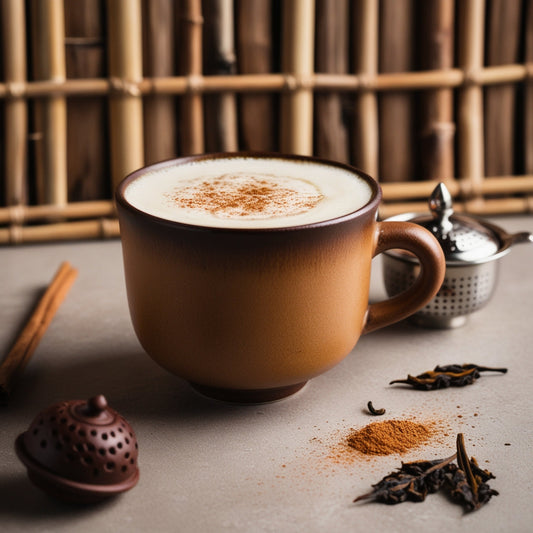Introduction
Imagine sipping a tea that not only transforms in taste over decades but also improves in value, much like a fine wine this is the taste profile of Pu-erh tea. On the other hand, picture a tea that captures the essence of young, minimally processed leaves, offering a delicate yet refreshing flavour,this is the charm of white tea. We will explore the distinctive characteristics, production processes, and health benefits of Pu-erh and White tea, providing a comprehensive comparison to help you understand and appreciate these exceptional teas.
Table of Content
- Introduction
- What is Pu-erh Tea?
- What is White Tea?
- Pu-erh Tea V/S White Tea
- Why is Pu-erh Tea best?
- Conclusion
What is Pu-erh Tea?
The tea is made from a larger leaf strain of Camellia sinensis, originating from ancient trees with leaves reputed to be between 500 and 1000 years old. Farmers grow these trees in temperate regions and can harvest them year-round, with mid-spring representing the optimal time. Various conditions and environmental factors impact Pu-erh flavour profile, resulting in a rich and bold tea experience that can be smooth, fruity, peaty, grassy, musky, herbal, and earthy.

What is White Tea?
White tea refers to several styles of tea, typically featuring young or minimally processed leaves of the Camellia sinensis plant. There is no universally accepted definition of white tea, and international agreement is limited. Some define white tea as simply dried without additional processing, while others describe it as made from buds and immature leaves picked just before they fully open, then allowed to wither and dry in natural sunlight. Another definition includes tea buds and very young leaves that undergo steaming or firing before drying. Generally, white tea is not rolled or oxidized, which results in a flavor that is "lighter" than most green or traditional black teas.
Despite its name, brewed white tea is pale yellow. The name comes from the fine silvery-white hairs on the unopened buds of the tea plant, giving it a whitish appearance. These unopened buds are used for some types of white tea. Harvested primarily in China's Fujian province, the basic manufacturing process for white tea involves fresh tea leaves undergoing withering and drying. White tea does not require panning, rolling, or shaking. The selection of raw materials is stringent, as only young tea leaves with fine hairs can produce high-quality white tea with a high grading value.
Pu-erh Tea V/S White Tea
Production Process
Pu-erh tea undergoes a more complex production process that includes greening, rolling, drying, and aging. It can be classified as either raw or cooked, depending on the specific methods used. White tea undergoes a minimal production process, involving natural withering. This gentle handling helps preserve the tea's delicate flavours and nutrients.
Taste
Pu-erh tea's taste improves over time, gaining both value and desirability as it ages. This aging process enhances its rich and robust flavour profile. As white tea ages, its taste evolves and becomes similar to that of Pu-erh tea. This transformation can enhance its appeal to those who appreciate aged teas.
Health Benefits
The health benefits of Pu-erh tea improve with age, making it a beneficial addition to a health-conscious diet. Its aging process can enhance its medicinal properties. White tea contains high levels of flavonoids, which contribute to its numerous health benefits. These compounds are potent antioxidants that can support overall health.
Colour
Pu-erh tea varies in colour depending on its type. Raw Pu-erh has a vibrant amber hue, while cooked Pu-erh exhibits a dark reddish-brown colour. The colour of white tea ranges from pale silver to light yellow, reflecting its delicate and subtle nature.
Caffeine Content
Pu-erh tea has moderate caffeine content, which varies depending on whether it is raw or cooked. This variability allows for different levels of stimulation based on personal preference. White tea generally contains lower caffeine levels, making it a suitable choice for those who are sensitive to caffeine or prefer a milder stimulant.

Why Pu-erh tea a better choice?
Pu-erh tea and white tea both provide unique health benefits, but Pu-erh tea often stands out for specific reasons. The fermentation process in Pu-erh tea enhances its antioxidant content and potential health benefits. It aids digestion, lowers cholesterol, and promotes weight loss. Additionally, Pu-erh tea improves cardiovascular health and offers a distinct, earthy flavor that matures over time, providing a unique taste experience. In contrast, white tea, although rich in antioxidants and known for its delicate flavor and minimal processing, may not offer the same level of benefits for digestion and cholesterol management.
Conclusion
Explore the world of tea with Puerh Craft and White tea, each offering unique flavours and benefits. Pu-erh entices with its rich, aged complexity, evolving in taste like fine wine over decades. On the other hand, white tea captivates with its delicate, light flavours and potent antioxidants. Whether you're drawn to Pu-erh robust profile or the subtle charm of white tea, both promise a journey of taste and health benefits.
Experience the world of Pu-erh tea,choose the best, brew a cup, and savour the distinctive flavours and health benefits of Pu-erh have to offer.
Q. What makes Pu-erh tea similar to fine wine in terms of its taste profile?
A.Pu-erh tea improves in taste over decades due to its post-fermentation process, much like how fine wine ages. The microbial fermentation process allows Pu-erh tea to develop rich, bold, and complex flavors over time.
Q. What are some of the distinctive flavor characteristics of Pu-erh tea?
A.Pu-erh tea can have a rich and bold flavor profile that includes smooth, fruity, peaty, grassy, musky, herbal, and earthy notes, which evolve and improve as the tea ages.
Q. What health benefits are associated with white tea?
A.White tea contains high levels of flavonoids, which are potent antioxidants that can support overall health. These compounds contribute to numerous health benefits, including boosting the immune system and protecting against cardiovascular disease.
Q. Why might someone prefer Pu-erh tea over white tea?
A.Someone might prefer Pu-erh tea because its fermentation process enhances its antioxidant content and health benefits, such as aiding digestion, lowering cholesterol, and promoting weight loss. Additionally, its unique and evolving taste profile, which matures over time, offers a distinct and enjoyable flavor experience.






